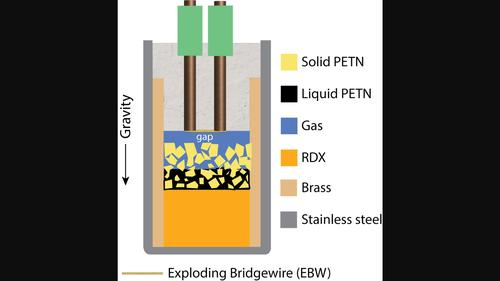当前位置:
X-MOL 学术
›
Propellants Explos. Pyrotech.
›
论文详情
Our official English website, www.x-mol.net, welcomes your
feedback! (Note: you will need to create a separate account there.)
A Liquid Stratification Model to Predict Failure in Thermally Damaged EBW Detonators
Propellants, Explosives, Pyrotechnics ( IF 1.7 ) Pub Date : 2022-08-08 , DOI: 10.1002/prep.202200097 Michael Hobbs 1 , Stephanie Coronel 2
Propellants, Explosives, Pyrotechnics ( IF 1.7 ) Pub Date : 2022-08-08 , DOI: 10.1002/prep.202200097 Michael Hobbs 1 , Stephanie Coronel 2
Affiliation

|
In previous work, commercially available downward facing exploding bridgewire detonators (EBWs) were exposed to elevated temperatures. These detonators were then initiated using a firing set which discharged a high amplitude short duration electrical pulse into a thin gold bridgewire. Responses of the detonators were measured using photonic doppler velocimetry (PDV) and high-speed photography. A time delay of 2 μs between EBW initiation and first movement of an output flyer separated operable detonators from inoperable detonators or duds. In the current work, we propose a simple method to determine detonator operability from the calculated state of the detonator at the time the firing set is initiated. The failure criterion is based on the gap distance between the exploding bridgewire (EBW) and the adjacent initiating explosive within the detonator which is low-density pentaerythritol tetranitrate (PETN) that melts between 413–415 K (140–142 °C). The gap forms as PETN melts and flows to the bottom of the input pellet. Melting of PETN is modeled thermodynamically as an energy sink using a normal distribution spread over a temperature range between the onset temperature of 413 K and the ending temperature of 415 K. The extent of the melt is determined from the average temperature of the PETN. The PETN liquid is assumed to occupy the interstitial gas volume in the lower part of the input pellet. The vacated volume from the relocated liquid forms the gap between the EBW and the PETN. The remaining sandwiched layer consists of solid PETN particles and gas filling interstitial volume. We predict that a threshold gap between 17–27 μm separates properly functioning detonators from duds.
中文翻译:

预测热损坏 EBW 雷管失效的液体分层模型
在以前的工作中,市售的向下爆炸桥线雷管 (EBW) 暴露在高温下。然后使用点火装置将这些雷管引爆,该点火装置将高幅度短持续时间的电脉冲释放到细金桥线中。使用光子多普勒测速仪 (PDV) 和高速摄影测量雷管的响应。在 EBW 启动和输出传单的第一次移动之间有 2 μs 的时间延迟,将可操作的雷管与不可操作的雷管或哑弹分开。在目前的工作中,我们提出了一种简单的方法来确定雷管的可操作性,该方法从点火装置启动时雷管的计算状态来确定。失效标准基于爆炸桥丝 (EBW) 与雷管内的相邻起爆药之间的间隙距离,雷管是在 413-415 K (140-142 °C) 之间熔化的低密度季戊四醇四硝酸酯 (PETN)。当 PETN 熔化并流到输入颗粒的底部时,就会形成间隙。PETN 的熔化在热力学上被建模为能量汇,使用分布在 413 K 的起始温度和 415 K 的结束温度之间的温度范围内的正态分布。熔化的程度由 PETN 的平均温度确定。假设 PETN 液体占据输入颗粒下部的间隙气体体积。从重新定位的液体中腾出的体积形成了 EBW 和 PETN 之间的间隙。剩余的夹层由固体 PETN 颗粒和填充间隙体积的气体组成。我们预测 17–27 μm 之间的阈值间隙将正常工作的雷管与哑弹分开。
更新日期:2022-08-08
中文翻译:

预测热损坏 EBW 雷管失效的液体分层模型
在以前的工作中,市售的向下爆炸桥线雷管 (EBW) 暴露在高温下。然后使用点火装置将这些雷管引爆,该点火装置将高幅度短持续时间的电脉冲释放到细金桥线中。使用光子多普勒测速仪 (PDV) 和高速摄影测量雷管的响应。在 EBW 启动和输出传单的第一次移动之间有 2 μs 的时间延迟,将可操作的雷管与不可操作的雷管或哑弹分开。在目前的工作中,我们提出了一种简单的方法来确定雷管的可操作性,该方法从点火装置启动时雷管的计算状态来确定。失效标准基于爆炸桥丝 (EBW) 与雷管内的相邻起爆药之间的间隙距离,雷管是在 413-415 K (140-142 °C) 之间熔化的低密度季戊四醇四硝酸酯 (PETN)。当 PETN 熔化并流到输入颗粒的底部时,就会形成间隙。PETN 的熔化在热力学上被建模为能量汇,使用分布在 413 K 的起始温度和 415 K 的结束温度之间的温度范围内的正态分布。熔化的程度由 PETN 的平均温度确定。假设 PETN 液体占据输入颗粒下部的间隙气体体积。从重新定位的液体中腾出的体积形成了 EBW 和 PETN 之间的间隙。剩余的夹层由固体 PETN 颗粒和填充间隙体积的气体组成。我们预测 17–27 μm 之间的阈值间隙将正常工作的雷管与哑弹分开。











































 京公网安备 11010802027423号
京公网安备 11010802027423号